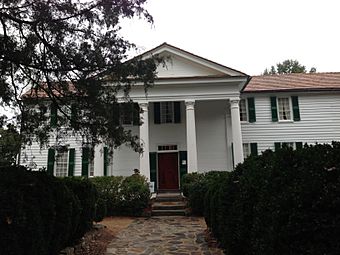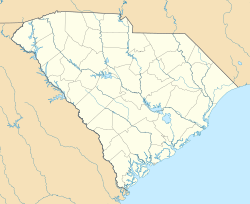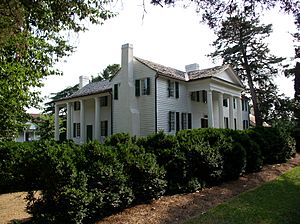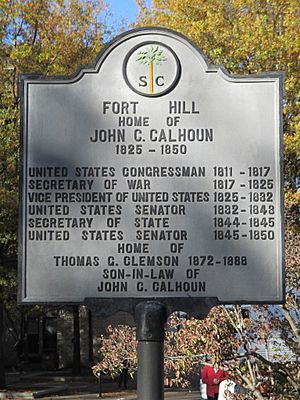Fort Hill (Clemson University, South Carolina) facts for kids
|
Fort Hill (John C. Calhoun House)
|
|
|
U.S. Historic district
Contributing property |
|
 |
|
| Location | Clemson University campus, Clemson postal address, South Carolina |
|---|---|
| Built | 1802 |
| Architectural style | Greek Revival |
| Part of | Clemson University Historic District II (ID89002139) |
| NRHP reference No. | 66000708 |
Quick facts for kids Significant dates |
|
| Added to NRHP | October 15, 1966 |
| Designated NHL | December 19, 1960 |
| Designated CP | January 4, 1990 |
Fort Hill is a very old house located on the Clemson University campus in South Carolina. It is also known as the John C. Calhoun House and Library. This historic home is a National Historic Landmark, which means it's a very important place in American history.
From 1825 to 1850, Fort Hill was the home of John C. Calhoun. He was a famous politician who served as the 7th Vice President of the United States. He had strong beliefs about states' rights, including a political idea called Nullification. This idea suggested that states could refuse to follow federal laws they believed were unconstitutional.
Clemson University was built on the land that was once the Fort Hill plantation in 1889. This plantation used enslaved people to work the land. Today, the house and a small part of the original land are kept as a museum and library. This was part of the agreement when the land was given to the state.
Contents
The Story of Fort Hill
Early Beginnings: Clergy Hall
The house we know as Fort Hill was first built around 1803. It was a smaller house with only four rooms. At that time, it was called Clergy Hall. Dr. James McElhenny, who was a pastor at Hopewell Presbyterian Church, lived there.
Calhoun's Home and Renaming
In 1825, John C. Calhoun and his wife, Floride Calhoun, moved into the house. Calhoun made the house much bigger, adding more rooms until it had 14. He then renamed it Fort Hill. This new name came from a nearby fort called Fort Rutledge, which was built around 1776. The house's design is in the Greek Revival style, which was popular for grand homes at the time.
Passing Through Generations
After John Calhoun passed away in 1850, his wife Floride inherited the property. This included the land and the enslaved people who worked there. She shared ownership with three of her children: Cornelia, John, and Anna Maria. Anna Maria was married to Thomas Green Clemson.
Later, Anna sold her part of the property to her mother, Floride. Floride then sold the entire plantation to her son, Andrew Pickens Calhoun. However, she still held the mortgage, which is like a loan on the property. When Andrew died in 1865, Floride started a legal process called foreclosure to get the property back from Andrew's heirs. She passed away in 1866.
The Estate's New Owners
After many legal steps, the plantation was sold at an auction in 1872. The person in charge of Floride's estate won the auction. The property was then divided among her children who were still alive. Her daughter, Anna Clemson, received the main house and about 814 acres of land. Her great-granddaughter, Floride Isabella Lee, received about 288 acres.
Thomas Green and Anna Clemson moved into Fort Hill in 1872. When Anna died in 1875, Thomas Green Clemson inherited the house and land.
Clemson University's Founding
In his will from 1888, Thomas Green Clemson gave more than 814 acres of the Fort Hill estate to the State of South Carolina. His wish was for an agricultural college to be built there. He also had a special rule for the Fort Hill house: it "shall never be torn down or altered." He wanted it to be kept in good condition with all its furniture and always be open for visitors to see.
Following his wishes, Clemson University was established. The university has continued to operate Fort Hill as a house museum, just as Thomas Green Clemson wanted. Today, the house is the only part left of what was once a very large plantation.
Fort Hill's Preservation
Fort Hill was recognized as a National Historic Landmark in 1960. This means it is a place of great historical importance to the entire country.
The house was closed for two years for a big restoration project and reopened in the spring of 2003. Fort Hill was also named a national treasure by the Save America's Treasures program. Its old items and furniture underwent a detailed conservation program. This work was supported by a federal grant and other funds.
More to Explore





